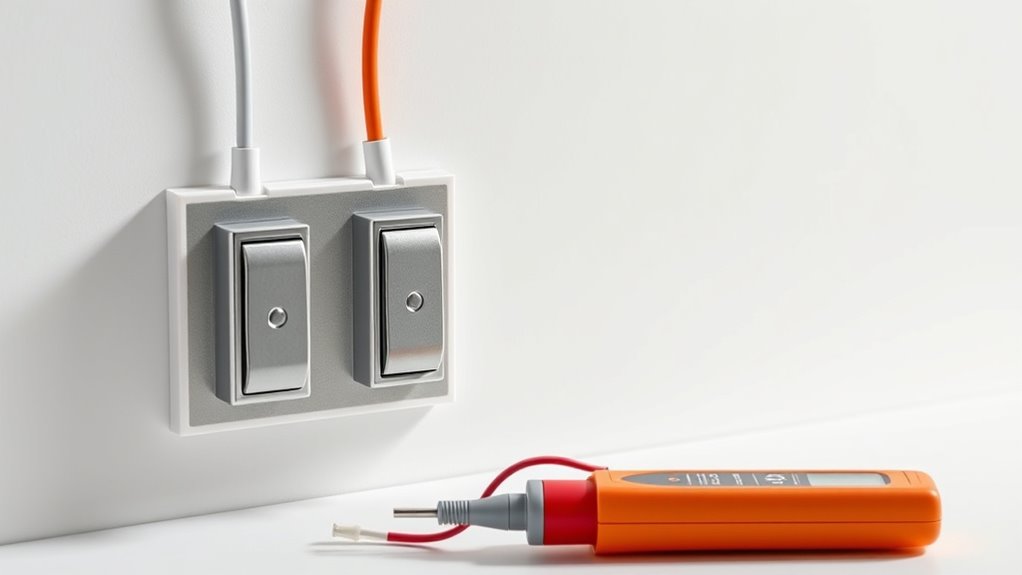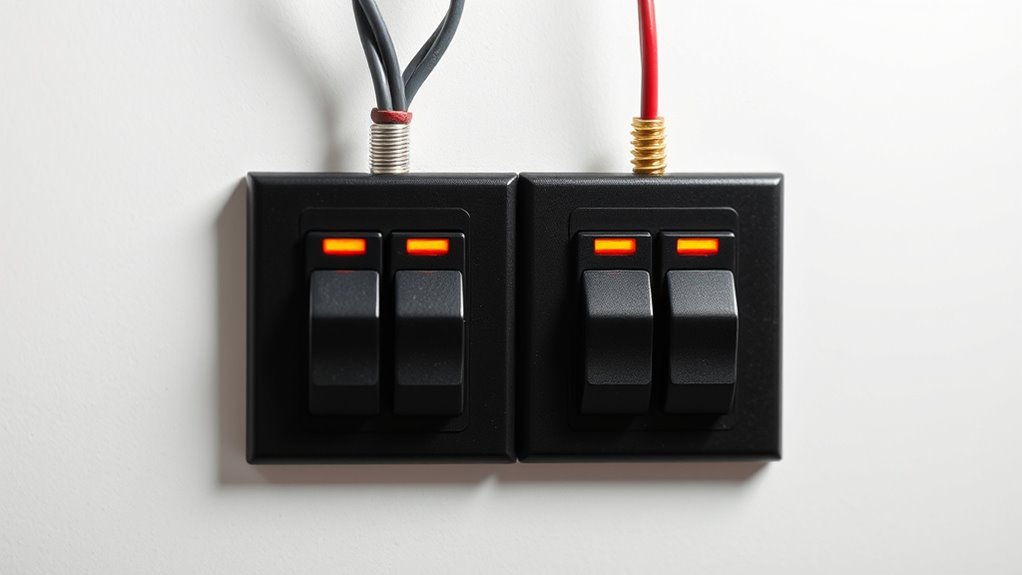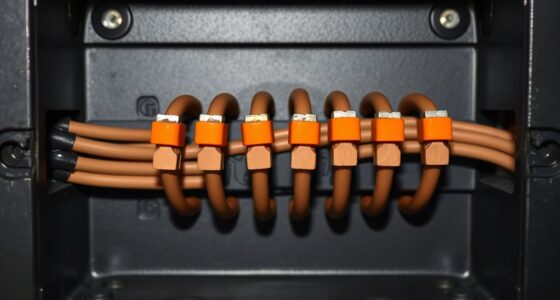A 3-way switch allows you to control a single light from two different locations, making it convenient to turn lights on or off from either spot. It works by using traveler wires that connect the switches, changing the circuit path when you toggle them. Proper wiring and components are essential for safe, reliable operation. If you keep exploring, you’ll gain a clear understanding of how to install and troubleshoot your 3-way switch system effectively.
Key Takeaways
- 3-way switches allow control of a single light from two different locations using traveler wires.
- Proper wiring involves connecting the common terminal, traveler terminals, and ground for reliable operation.
- Toggling either switch changes the circuit pathway, turning the light on or off from both spots.
- Use compatible switches, correct wiring, and safety checks to ensure seamless control and code compliance.
- Troubleshooting involves verifying connections, testing switches, and ensuring power is turned off during installation.
Understanding the Basics of 3-Way Switches

A 3-way switch allows you to control a single light fixture from two different locations. To understand how it works, you need to know some switch terminology: traveler wires, common terminal, and switch leg. The traveler wires connect the two switches, enabling the control from either point, while the common terminal links to the fixture or power source. When installing or replacing 3-way switches, you must follow electrical codes to guarantee safety and proper operation. These codes specify wire gauges, grounding requirements, and switch ratings. Unlike standard switches, 3-way switches don’t have on/off markings; instead, their toggle positions work together to control the light. Grasping these basics ensures you can correctly install or troubleshoot your 3-way switch system. Additionally, understanding self watering plant pots can help in maintaining healthy indoor plants with minimal effort, especially in spaces with controlled lighting. Being aware of electrical safety standards is essential to prevent hazards during installation or repairs.
How a 3-Way Switch Circuit Works

You’ll see how the circuit pathways connect when you flip a 3-way switch, enabling the light to turn on or off from either location. The switch operation mechanics involve changing the connection points to complete or break the circuit. Understanding these pathways helps you grasp how both switches work together to control the light seamlessly. Proper wiring tip size selection is essential for ensuring efficient operation and safety. Additionally, familiarizing yourself with industry trends can help you stay updated on best practices for wiring and safety standards. Using the correct paint sprayer types can also improve the quality and safety of your projects. Being aware of sprayer maintenance routines ensures consistent performance and prolongs the lifespan of your equipment. Moreover, understanding electrical safety standards is crucial for preventing hazards during installation and maintenance.
Circuit Pathways Explained
Understanding how a 3-way switch circuit works involves grasping how its circuit pathways connect to control a single light from two different locations. In this setup, the wiring creates a continuous loop, allowing you to switch the light on or off from either switch. When you toggle a switch, it changes the pathway, either completing or breaking the circuit. These circuit pathways include travelers—two wires that connect the switches—and a common wire linked to the power source or the light fixture. The switches work together by redirecting current through different routes, depending on their position. This design ensures seamless lighting control, giving you the flexibility to operate the light from two spots without complex wiring. Additionally, understanding circuit pathways helps in troubleshooting and ensuring safe electrical connections. Recognizing how small mistakes in wiring can lead to issues emphasizes the importance of careful installation, especially when dealing with complex electrical configurations. Proper knowledge of wiring diagrams can significantly reduce the risk of errors during installation. Moreover, familiarity with correct wiring techniques is crucial for maintaining safety and functionality in your electrical system.
Switch Operation Mechanics
When you flip a 3-way switch, it changes the path that electrical current follows through the circuit. This switch design allows you to control lighting from two different locations. Inside, the switch has two traveler terminals connected by internal toggles that alternate the circuit paths. When you switch positions, it either completes or breaks the connection between the travelers, changing the current route. This toggle action is what enables lighting control from multiple spots. Additionally, understanding the switch operation mechanics helps in troubleshooting and proper installation. Proper wiring ensures reliable operation and prevents potential electrical issues, making installation accuracy crucial. A clear understanding of the circuit design further supports effective troubleshooting and safe setup. Recognizing how the travelers connect within the circuit can assist in diagnosing issues if the switches do not operate correctly, especially when understanding the circuit pathways is essential for resolving wiring problems.
Components Needed for Installing a 3-Way Switch

To install a 3-way switch, you’ll need several key components to guarantee proper functionality and safety. First, you’ll require two 3-way switches, which control the same light from different locations. You’ll also need appropriate wiring, including travelers and a common wire, to connect the switches correctly. If you’re exploring wireless alternatives, consider smart switches that support remote control and automation, reducing the need for extensive wiring. Additionally, decorative switch covers help improve aesthetics and protect the switches from dust and damage. Make sure to select covers that fit your switch style and match your decor. Always verify that your components meet local electrical codes for safety. When working on electrical systems, understanding electrical wiring and proper installation techniques is crucial for safety and performance. Proper wiring practices are essential for ensuring reliable switch operation and avoiding potential hazards. Familiarity with electrical safety guidelines can prevent accidents during installation. Gathering these essentials ensures a smooth installation process and reliable operation of your 3-way lighting system.
Step-by-Step Guide to Installing a 3-Way Switch

To install a 3-way switch, you’ll start by gathering the right tools and materials. Next, you’ll follow specific wiring and connection steps to guarantee everything is set up correctly. Properly understanding electrical safety is essential before beginning any wiring project, as it helps prevent electric shock and accidents. Additionally, it’s helpful to know about home security systems and their features, as they can offer added protection for your property. Being aware of local electrical codes ensures your installation complies with safety standards. Furthermore, understanding circuit breakers can help you manage electrical load and prevent overloads during installation. Ready to get started?
Tools and Materials Needed
Before you start installing a 3-way switch, gather the essential tools and materials. Proper preparation guarantees a smooth process, especially when considering color coding and switch placement. You’ll need:
- A voltage tester to ensure power is off
- A flat-head and Phillips screwdriver for wiring and switch removal
- Wire strippers to prepare the cables
- 3-way switches compatible with your wiring setup
Having these tools ready helps you correctly identify wires and maintain safety. Pay attention to color coding of the wires—common, traveler, and ground—to ensure proper switch placement and connections. Confirm the switch’s specifications match your existing wiring. This preparation minimizes mistakes and keeps the installation efficient and safe. Additionally, understanding the complexities of wiring can help you troubleshoot issues more effectively.
Wiring and Connection Steps
Wiring a 3-way switch involves carefully connecting the traveler, common, and ground wires to guarantee proper operation. First, identify the wire color codes: black or red for travelers, a different black or copper for the common, and green or bare for ground. Switch placement matters; install switches where they’re easily accessible.
| Step | Action | Notes |
|---|---|---|
| 1 | Turn off power at the breaker. | Confirm with a tester. |
| 2 | Connect the ground wire to the switch’s ground terminal. | Usually green or bare copper. |
| 3 | Attach traveler wires (red/black) to traveler terminals. | Match the wire colors correctly. |
Follow these steps to ensure safe, correct wiring.
Troubleshooting Common Issues With 3-Way Switches

Troubleshooting common issues with 3-way switches can often be straightforward if you understand the underlying causes. Many problems stem from wiring issues, faulty switches, or incompatible devices like dimmer switches. First, check your wiring diagram to verify all connections are correct. If the switch isn’t working, try replacing it with a known-good one. For flickering or dimming issues, verify that your dimmer switch is compatible with 3-way setups. Loose wires or bad connections can also cause intermittent operation. Additionally, inspect for damaged wiring or loose screws. Here are some steps to troubleshoot:
- Confirm wiring matches the diagram
- Replace malfunctioning switches
- Ensure dimmer switches are compatible
- Tighten or replace loose wiring connections
Tips for Safe and Effective 3-Way Switch Installation

Installing 3-way switches safely and effectively requires careful attention to detail and adherence to proper procedures. Start by guaranteeing grounding safety; always connect the ground wire securely to prevent electrical shocks and ensure code compliance. When planning switch placement, choose accessible locations that don’t obstruct movement or future upgrades. Double-check that the power is turned off before working on wiring to avoid accidents. Use the correct wire types and match your wiring connections precisely to avoid malfunctions. Proper switch placement not only improves safety but also makes troubleshooting easier later. Keep your work neat and organized, and test the switches thoroughly before restoring power. Following these tips helps ensure a safe, reliable, and efficient installation process.
Frequently Asked Questions
Can 3-Way Switches Be Used With Smart Home Systems?
Yes, you can use 3-way switches with smart home systems. Look for smart 3-way switches that offer smart home compatibility, allowing you to control your lights via apps or voice commands. Many models support wireless control, making it easy to integrate into your existing setup. Just verify your smart switches are compatible with your smart home platform, and you’ll enjoy seamless, remote lighting control from multiple locations.
What Is the Maximum Length for 3-Way Switch Wiring?
You should keep 3-way switch wiring within 100 feet to guarantee wiring safety and maintain switch lifespan. Exceeding this length can lead to voltage drops and potential hazards, reducing the switch’s durability. Properly sizing wires and avoiding overly long runs help prevent issues. Always follow electrical codes and consult a professional if you’re unsure, as safe wiring practices are essential for long-lasting, reliable switch operation.
Are 3-Way Switches Compatible With LED or CFL Bulbs?
You might be surprised, but 3-way switches are compatible with LED and CFL bulbs if you consider bulb compatibility and wiring requirements. Modern switches often work well with energy-efficient bulbs, provided you choose dimmable LED or CFL options and verify your switch supports dimming if needed. Always check the switch’s specifications for compatibility, and follow wiring instructions carefully to avoid flickering or other issues.
How Do I Identify the Traveler Wires in a 3-Way Switch Setup?
To identify traveler wires in a 3-way switch setup, turn off the power first. Remove the switch cover and look at the terminals; traveler wiring typically connects the two brass-colored screws. Use a voltage tester to confirm which wires are live and then trace them between switches. Traveler wires usually run between two switches, so identify the two wires that connect the traveler terminals. This helps verify proper wire identification and safe installation.
Is Professional Installation Necessary for Complex 3-Way Switch Configurations?
You don’t always need a professional for complex 3-way switch configurations, but DIY wiring requires careful attention to safety precautions. If you’re experienced, you can handle it, but if you’re unsure or the setup involves advanced wiring, it’s best to hire an electrician. Complex circuits increase the risk of electrical shock or fire, so prioritize safety and make sure to turn off power before working on any wiring.
Conclusion
Now that you’ve decoded the mystery of 3-way switches, you’re like a conductor guiding the flow of light through a symphony of switches. With the right tools and steps, you can orchestrate your lighting setup smoothly and safely. Think of it as wielding a magic wand—controlling lights from two spots with confidence and precision. So go ahead, light up your space with newfound knowledge, and make your home’s lighting both smart and effortless.









